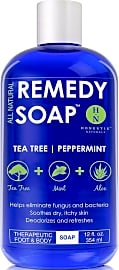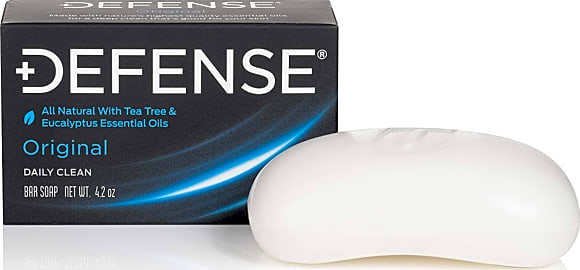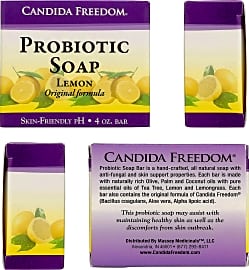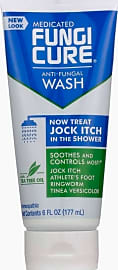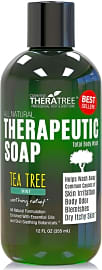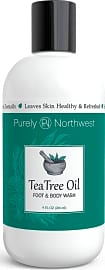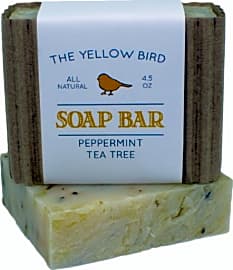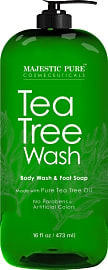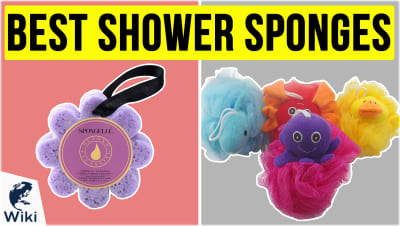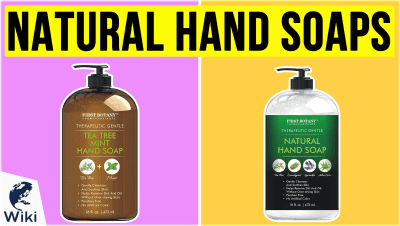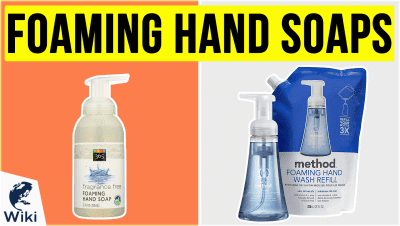The 10 Best Antifungal Soaps

This wiki has been updated 33 times since it was first published in December of 2016. Whether you suffer from jock itch, ringworm, athlete's foot or another similarly-caused skin malady, one of these anti-fungal soaps and body washes can help. Check with your doctor before using them to ensure they are safe for your needs, but as long as you get the go-ahead, you should find they are effective not only at treating an existing condition, but also as a preventative measure. When users buy our independently chosen editorial recommendations, we may earn commissions to help fund the Wiki.
Editor's Notes
July 18, 2020:
While we made sure to take effectiveness into account when putting together this list, since the main point of buying an antifungal soap is to get rid of whatever fungus is causing your problem, we also considered fragrance, the ingredients and any additional benefits they offer, and individual bathing habits. Before using any of these products, no matter how gentle they may seem, it is a smart idea to check with your doctor to make sure they are suitable for your needs. We also recommend using a shower sponge with most of these to get maximum effectiveness.
For those who prefer not to use a wash, we have included Defense Daily Clean Bars and The Yellow Bird Peppermint & Tea Tree Bar. The former comes in three scents, all of which should be effective at fighting both bacteria and fungi, while the latter is an artisan-made product comprised almost entirely of organic ingredients. Both are free of sulfates and alcohol, so are very gentle on the skin.
When it comes to the washes, FungiCure Medicated immediately stands out for its inclusion of sepia 12x, which has been used in homeopathic medicine for generations. While there is little literature to support its fungicidal properties, there is probably something to it if people have continued to use it for so long. Plus, it also contains tea tree oil, which you'll see is in every product on this list and is generally regarded as one of the best natural antifungals. Purely Northwest Foot and Body Wash is another one that stands out for its potential for preventing lice. Unfortunately, it does contain sodium laureth sulfate.
While many of the soaps on this list require you to leave them on the skin for anywhere from 30 seconds to a minute or longer to be effective, the makers of Viking Revolution Extra-Strength boasts that it only requires five seconds of exposure to combat fungal infections, making it a great choice for those with limited patience.
July 02, 2019:
Our skin naturally hosts fungi, but when they get imbalanced or start to spread wildly, that's when we get itchy blotches and rashes called tinea, or more commonly, jock itch, ringworm, or athlete's foot. Sometimes these conditions are serious enough to warrant prescription treatment, but they can often be cleared up by over-the-counter remedies, including the anti-fungal soaps ranked in our selections.
In this update, we looked for products that, above all else, are effective on these kinds of fungus infections. We also considered value for the price and cosmetic characteristics such as smell and lather. We removed one item due to concerns about its availability and added the relatively new Viking Revolution Body Wash in one of our top slots because it works really well for a lot of users.
What's The Deal With Fungus?
While the concept may conjure images of woodland mushrooms sprouting from one's underarms, bodily fungus takes many forms.
Antifungals, which come in many forms, including prescription medications, are designed to treat the growth of fungus on the body. While the concept may conjure images of woodland mushrooms sprouting from one's underarms, bodily fungus takes many forms. Fear not — none of those forms are actual mushrooms.
Technically speaking, the term fungus includes anything in the fungi kingdom, which sits somewhere in between the plant and animal kingdoms in terms of the organisms it contains. Like animals, fungi acquire sustenance by absorbing dissolved food molecules. In the case of bodily fungus, that food is your flesh. But fungi can feed on just about any type of organic matter, which is why you can find various types of fungus everywhere from tree trunks to the grout between your shower tiles. Mold is also a fungus, and if you've ever held on to a loaf of bread or a piece of fruit for too long, you know it can grow just about anywhere.
It's important to remember that not all fungus is bad. Aside from the portobellos, shiitakes, and other edible mushrooms that add delicious flavor to dishes from around the world, many types of fungus have health benefits. Fungus plays a vital role in an incredible number of medications, including antibiotics, cholesterol-lowering drugs, anti-cancer treatments, and antivirals. Certain fungi can even be used to treat fungal infections.
Fungi also play a vital role in the decomposition of organic matter. Yeasts are a form of fungus, and without them we could not have the fermentation processes that give us beer, wine, spirits, and of course, bread.
Though humans have been studying and experimenting with fungi for thousands of years, our knowledge of them remains fairly limited. It is estimated that there are between two and four million species within the kingdom fungi, many of which are microscopic, yet we have only documented about 120,000 so far. Because of the kingdom's vast biodiversity, it's no surprise that its species play such varied roles in our lives. Fungi can kill us, heal us, make us hallucinate, feed us, and feed on us.
It can be a bit difficult to wrap your mind around, especially when you think about the fact that one genus of fungi is responsible for both penicillin and the making of brie, camembert, and blue cheeses. But rather than focusing on the vastness of the fungal kingdom, if you have a bodily fungus like athlete's foot, you'd probably prefer to focus on getting rid of it. That's what antifungal soaps are meant to do.
How Soap Is Made
Humans have been producing soap for nearly five thousand years, since ancient Babylonian times. Generally speaking, the production of soap involves combining a plant or animal fat with an alkaline substance, such as lye. In ancient soaps, the typical alkali used was ash, though limestone was also popular in areas where it naturally occurred. As continues to be the case, fragrance was often added to enhance the experience of the finished product.
There are two basic processes that make soap, one hot and one cold. These processes are the same ones that both artisanal and industrial soap-makers use, the only difference being the scale of production.
In addition to fragrances and other additives, one can add dyes to achieve colorful results and unique patterns.
In truth, the cold process of making soap does involve some heat. However, that heat is typically generated from the chemical reaction of mixing lye with oil, unlike the hot process, which uses an external heat source. Both processes require the dissolution of lye in water before mixing it into the oil. Once mixed, the substance begins to thicken, at which point it is safe to add other ingredients to enhance the final product, like fragrances and antifungals.
Once mixed, the soap can be poured into molds and left to cure. During this process, the excess water evaporates and the soap becomes increasingly solid. For cold process soaps, this can take up to eight weeks to complete, depending on the amount of water used, as well as the ambient temperature and humidity. Hot process soaps cure more quickly, because the heat applied in the mixing process expedites the chemical reaction that leads to saponification.
The process of making soap is fairly simple and highly customizable. In addition to fragrances and other additives, one can add dyes to achieve colorful results and unique patterns. A wide range of oils is acceptable, according to the preferences of the manufacturer as well as the desired qualities of the finished product. Oils like coconut, almond, and palm create a more bubbly lather. Milk, yogurt, and aloe vera can replace some or all of the water used to create a smoother texture. The hardness of the finished product can be altered by adjusting the ratio of oils that are solid at room temperature to those that are liquid.
The Uses And Limits Of Antifungal Soap
There is a wide range of antifungal soaps on the market. They differ from the more common antibacterial variety in that they contain ingredients that are specifically designed to treat fungus on your body. Common active ingredients include ketoconazole and miconazole, which are synthetic antifungal medications, as well as plant-based substances like tea tree oil and benzoic acid.
Depending on the type you buy, antifungal soap can treat a wide variety of conditions.
Depending on the type you buy, antifungal soap can treat a wide variety of conditions. These range from conditions which cause body odor to athlete's foot, nail fungus, and jock itch. They can also treat many skin irritations, as well as medical conditions like ringworm and tinea versicolor, the latter of which is a common cause of skin discoloration.
If you're suffering from something you think might be a result of a fungal infection but antifungal soap doesn't seem to be doing the trick, it's a good idea to see a doctor. You may need something more potent to take care of certain conditions. A variety of prescription medications and creams is available to those who need them. If your condition seems to be worsening despite or even as a result of the use of one of these soaps, you should strongly consider taking medical action sooner rather than later.


